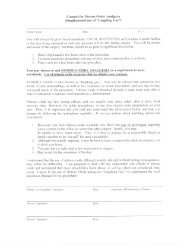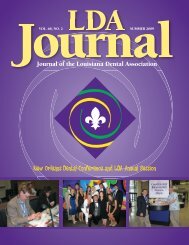Be Our Friend - Louisiana Dental Association
Be Our Friend - Louisiana Dental Association
Be Our Friend - Louisiana Dental Association
Create successful ePaper yourself
Turn your PDF publications into a flip-book with our unique Google optimized e-Paper software.
Endorsed Products and ServicesSPOTLIGHTCreating a Lean <strong>Dental</strong> Office:The <strong>Be</strong>nefits of Implementing Electronic Claims TechnologyRichard MoorePresident/CEO, Mercury Data Exchange (MDE)<strong>Dental</strong> practices face many challenges in today’seconomic environment. You have to maintainprofitability while making sure that patient productionkeeps up with the costs of doing business. Of course,there are times when decreased production is inevitable,despite your best efforts to get patients into the chair.That is when it becomes more important than ever to besure that office production is efficient, or lean.“Lean production” involves doing more with less byeliminating the things your office does that cost youtime and/or money. It might be something as simple asreplacing paper-based insurance claims processes withelectronic-based claims processes.Staggering statisticsImplementing electronic claims processing is aninvestment toward a lean production system – onethat will streamline the process and produce financialgains in the future. The average rejection rate for paperclaims is 25 percent, compared to a rejection rate ofless than two percent for electronic claims. Assumingthere are no rejections, electronic claims are processedwithin 15 to 21 days on average, while paper claimstake 30 to 60 days to process. When a paper claimis rejected, the average processing time doubles; bycontrast, rejected electronic claims can be sent backto the provider within the same business day forreconciliation when real-time technology is being used.If an electronic claims processing system canminimize payment delays, it can ultimately reduce apractice’s administrative costs. According to publishedreports, approximately 20 percent of health carecosts in the U.S. are related to transactions, includingmanual data entry, eligibility verification and claimsand payment processing. Processing electronic claimscosts 46 percent less than processing paper claims.Slim down the paper stacksAs of a December 2009 report released by theAmerican <strong>Dental</strong> <strong>Association</strong> (ADA), approximately50 percent of dentists still relied on paper claims.That means printing out the many papers and formsrequired for claims processing. This translates into hardcosts for paper, printing, and postage - not to mentionstaff time spent compiling the necessary information,facilitating various mailings and conducting follow-upcalls with payers and patients.If you have a general one-dentist practice thatsubmits an average of 2,000 claims a year, you arecreating at least 10,000 pieces of paper annually –more if any of your claims are rejected.Optimizing electronic processingWhile moving to an electronic platform for claimstransactions can improve your administrative efficiency,real-time adjudication technology offers a chance toexpedite the process even further. Here is a step-bystepreview of how real-time communications affect thetransactions related to a patient’s visit.1. Eligibility: To verify eligibility manually,office staff must call each insurer or check thepayer’s website to determine whether or not thepatient is eligible for treatment and collect themost up-to-date benefits information to helpdetermine treatments and patient payments.Real-time eligibility verification enables staffto submit an electronic request for patienteligibility, co-payment amount and other benefitsinformation can be secured before the patientreaches the office.2. Predetermination: Predetermination or preauthorizationprocesses typically occur after theinitial examination is over and the patient has leftthe office. These communications often requirestaff to mail in forms and documentation andplace follow-up calls to patients and insuranceproviders before determining the next steps in atreatment plan. Real-time predetermination andpre-authorization of benefits allow staff membersto inform the patient of the exact amount adental insurer will pay for each treatment planwithout the need for follow-up calls. At the sameSpring 2011 15















